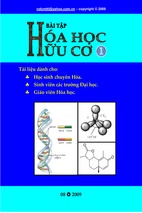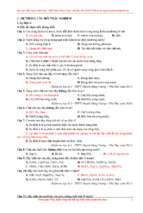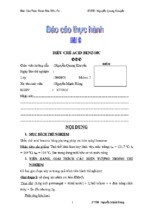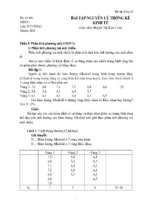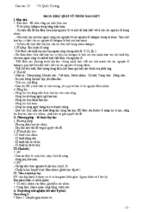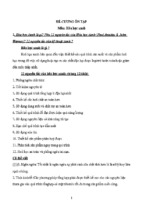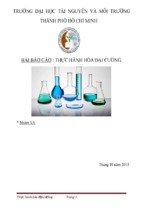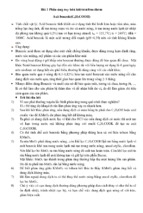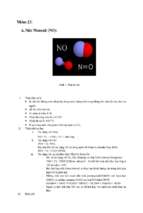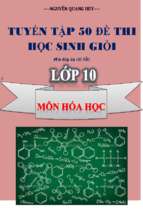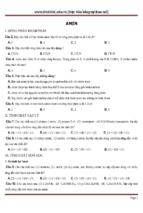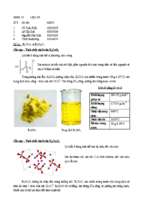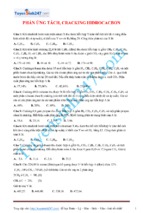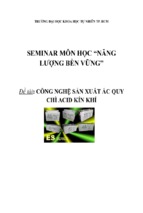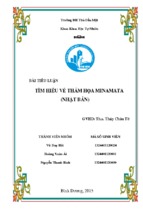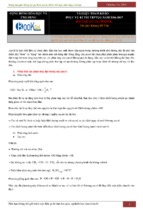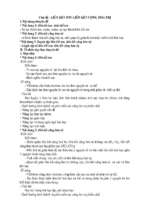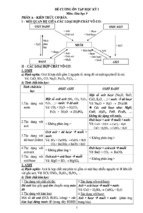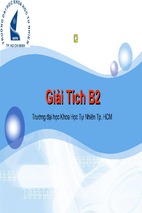Organic Chemistry II For Dummies - John T. Moore, Richard H. Langley
er!™
si
a
E
g
in
th
ry
e
v
E
Making
Organic
I
I
y
r
t
s
i
Chem
Learn to:
• Understand the physical and chemical
properties of organic compounds
• Observe from a macro-scopic and
micro-scopic view
• Grasp chemical and organic reactions
• Follow along and ace your Organic
Chemistry II course
John T. Moore, EdD
Richard H. Langley, PhD
Professors of Chemistry and coauthors of
Biochemistry For Dummies
Organic
Chemistry II
FOR
DUMmIES
‰
by John T. Moore, EdD, and
Richard H. Langley, PhD
Organic Chemistry II For Dummies®
Published by
Wiley Publishing, Inc.
111 River St.
Hoboken, NJ 07030-5774
www.wiley.com
Copyright © 2010 by Wiley Publishing, Inc., Indianapolis, Indiana
Published simultaneously in Canada
No part of this publication may be reproduced, stored in a retrieval system or transmitted in any form or
by any means, electronic, mechanical, photocopying, recording, scanning or otherwise, except as permitted under Sections 107 or 108 of the 1976 United States Copyright Act, without either the prior written
permission of the Publisher, or authorization through payment of the appropriate per-copy fee to the
Copyright Clearance Center, 222 Rosewood Drive, Danvers, MA 01923, (978) 750-8400, fax (978) 646-8600.
Requests to the Publisher for permission should be addressed to the Permissions Department, John Wiley
& Sons, Inc., 111 River Street, Hoboken, NJ 07030, (201) 748-6011, fax (201) 748-6008, or online at http://
www.wiley.com/go/permissions.
Trademarks: Wiley, the Wiley Publishing logo, For Dummies, the Dummies Man logo, A Reference for the
Rest of Us!, The Dummies Way, Dummies Daily, The Fun and Easy Way, Dummies.com, Making Everything
Easier, and related trade dress are trademarks or registered trademarks of John Wiley & Sons, Inc. and/
or its affiliates in the United States and other countries, and may not be used without written permission.
All other trademarks are the property of their respective owners. Wiley Publishing, Inc., is not associated
with any product or vendor mentioned in this book.
LIMIT OF LIABILITY/DISCLAIMER OF WARRANTY: THE PUBLISHER AND THE AUTHOR MAKE NO
REPRESENTATIONS OR WARRANTIES WITH RESPECT TO THE ACCURACY OR COMPLETENESS OF
THE CONTENTS OF THIS WORK AND SPECIFICALLY DISCLAIM ALL WARRANTIES, INCLUDING WITHOUT LIMITATION WARRANTIES OF FITNESS FOR A PARTICULAR PURPOSE. NO WARRANTY MAY BE
CREATED OR EXTENDED BY SALES OR PROMOTIONAL MATERIALS. THE ADVICE AND STRATEGIES
CONTAINED HEREIN MAY NOT BE SUITABLE FOR EVERY SITUATION. THIS WORK IS SOLD WITH THE
UNDERSTANDING THAT THE PUBLISHER IS NOT ENGAGED IN RENDERING LEGAL, ACCOUNTING, OR
OTHER PROFESSIONAL SERVICES. IF PROFESSIONAL ASSISTANCE IS REQUIRED, THE SERVICES OF
A COMPETENT PROFESSIONAL PERSON SHOULD BE SOUGHT. NEITHER THE PUBLISHER NOR THE
AUTHOR SHALL BE LIABLE FOR DAMAGES ARISING HEREFROM. THE FACT THAT AN ORGANIZATION OR WEBSITE IS REFERRED TO IN THIS WORK AS A CITATION AND/OR A POTENTIAL SOURCE
OF FURTHER INFORMATION DOES NOT MEAN THAT THE AUTHOR OR THE PUBLISHER ENDORSES
THE INFORMATION THE ORGANIZATION OR WEBSITE MAY PROVIDE OR RECOMMENDATIONS IT
MAY MAKE. FURTHER, READERS SHOULD BE AWARE THAT INTERNET WEBSITES LISTED IN THIS
WORK MAY HAVE CHANGED OR DISAPPEARED BETWEEN WHEN THIS WORK WAS WRITTEN AND
WHEN IT IS READ.
For general information on our other products and services, please contact our Customer Care
Department within the U.S. at 877-762-2974, outside the U.S. at 317-572-3993, or fax 317-572-4002.
For technical support, please visit www.wiley.com/techsupport.
Wiley also publishes its books in a variety of electronic formats. Some content that appears in print may
not be available in electronic books.
Library of Congress Control Number: 2010926849
ISBN: 978-0-470-17815-7
Manufactured in the United States of America
10 9 8 7 6 5 4 3 2 1
About the Authors
John T. Moore, EdD, grew up in the foothills of western North Carolina. He
attended the University of North Carolina–Asheville where he received his
bachelor’s degree in chemistry. He earned his master’s degree in chemistry
from Furman University in Greenville, South Carolina. After a stint in the
United States Army, he decided to try his hand at teaching. In 1971 he joined
the chemistry faculty of Stephen F. Austin State University in Nacogdoches,
Texas, where he still teaches chemistry. In 1985 he went back to school
part time and in 1991 received his doctorate in education from Texas A&M
University. For the past several years he has been the co-editor (along
with one of his former students) of the “Chemistry for Kids” feature of The
Journal of Chemical Education. In 2003 his first book, Chemistry For Dummies,
was published by Wiley, soon to be followed by Chemistry Made Simple
(Broadway) and Chemistry Essentials For Dummies (Wiley). John enjoys
cooking and making custom knife handles from exotic woods.
Richard H. Langley, PhD, grew up in southwestern Ohio. He attended Miami
University in Oxford, Ohio, where he received bachelor’s degrees in chemistry
and in mineralogy and a master’s degree in chemistry. His next stop was the
University of Nebraska in Lincoln, Nebraska, where he received his doctorate
in chemistry. Afterwards he took a postdoctoral position at Arizona State
University in Tempe, Arizona, followed by a visiting assistant professor
position at the University of Wisconsin–River Falls. In 1982 he moved to
Stephen F. Austin State University. For the past several years he and John
have been graders for the free-response portion of the AP Chemistry Exam.
He and John have collaborated on several writing projects, including 5 Steps
to a Five AP Chemistry and Chemistry for the Utterly Confused (both published
by McGraw-Hill). Rich enjoys jewelry making and science fiction.
Dedication
John: I dedicate this book to my wife, Robin; sons, Matthew and Jason; my
wonderful daughter-in-law, Sara; and the two most wonderful grandkids in
the world, Zane and Sadie. I love you guys.
Rich: I dedicate this book to my mother.
Authors’ Acknowledgments
We would not have had the opportunity to write this book without the
encouragement of our agent Grace Freedson. We would also like to thank
Chrissy Guthrie for her support and assistance in the early portion of this
project and to Sarah Faulkner who helped us complete it. We would also like
to thank our copy editor, Caitie Copple, and our technical editors, Susan
Klein and Joe Burnell.
Many thanks to our colleagues Russell Franks and Jim Garrett who helped
with suggestions and ideas. Rich would also like to acknowledge Danica
Dizon for her suggestions, ideas, and inspiration. Thanks to all of the people
at Wiley publishing who help bring this project from concept to publication.
Publisher’s Acknowledgments
We’re proud of this book; please send us your comments at http://dummies.custhelp.com.
For other comments, please contact our Customer Care Department within the U.S. at 877-762-2974,
outside the U.S. at 317-572-3993, or fax 317-572-4002.
Some of the people who helped bring this book to market include the following:
Acquisitions, Editorial, and
Media Development
Project Editors: Sarah Faulkner,
Christina Guthrie
Senior Acquisitions Editor:
Lindsay Sandman Lefevere
Copy Editor: Caitlin Copple
Composition Services
Project Coordinator: Patrick Redmond
Layout and Graphics: Nikki Gately
Proofreaders: Laura Albert, Sossity R. Smith
Indexer: Sharon Shock
Special Help Jennifer Tebbe
Assistant Editor: Erin Calligan Mooney
Senior Editorial Assistant: David Lutton
Technical Editors: Susan J. Klein, PhD,
Joe C. Burnell, PhD
Editorial Manager: Christine Meloy Beck
Editorial Assistants: Jennette ElNaggar,
Rachelle S. Amick
Cover Photos:
© Haywiremedia | Dreamstime.com/ © iStock
Cartoons: Rich Tennant
(www.the5thwave.com)
Publishing and Editorial for Consumer Dummies
Diane Graves Steele, Vice President and Publisher, Consumer Dummies
Kristin Ferguson-Wagstaffe, Product Development Director, Consumer Dummies
Ensley Eikenburg, Associate Publisher, Travel
Kelly Regan, Editorial Director, Travel
Publishing for Technology Dummies
Andy Cummings, Vice President and Publisher, Dummies Technology/General User
Composition Services
Debbie Stailey, Director of Composition Services
Contents at a Glance
Introduction ................................................................ 1
Part I: Brushing Up on Important
Organic Chemistry I Concepts ....................................... 7
Chapter 1: Organic Chemistry II: Here We Go Again! .................................................... 9
Chapter 2: Remembering How We Do It: Mechanisms................................................ 17
Chapter 3: Alcohols and Ethers: Not Just for Drinking and Sleeping ........................ 31
Chapter 4: Conjugated Unsaturated Systems............................................................... 53
Chapter 5: “Seeing” Molecules: Spectroscopy Revisited ............................................ 67
Part II: Discovering Aromatic (And Not
So Aromatic) Compounds ........................................... 79
Chapter 6: Introducing Aromatics ................................................................................. 81
Chapter 7: Aromatic Substitution Part I: Attack of the Electrophiles....................... 93
Chapter 8: Aromatic Substitution Part II: Attack of the
Nucleophiles and Other Reactions ........................................................................... 111
Part III: Carbonyls: Good Alcohols Gone Bad ............. 121
Chapter 9: Comprehending Carbonyls........................................................................ 123
Chapter 10: Aldehydes and Ketones ........................................................................... 137
Chapter 11: Enols and Enolates ................................................................................... 161
Chapter 12: Carboxylic Acids and Their Derivatives ................................................ 187
Part IV: Advanced Topics (Every
Student’s Nightmare) .............................................. 219
Chapter 13: Amines and Friends .................................................................................. 221
Chapter 14: Metals Muscling In: Organometallics ..................................................... 249
Chapter 15: More Reactions of Carbonyl Compounds.............................................. 261
Chapter 16: Living Large: Biomolecules...................................................................... 281
Part V: Pulling It All Together .................................. 309
Chapter 17: Overview of Synthesis Strategies ........................................................... 311
Chapter 18: Roadmaps and Predicting Products....................................................... 327
Part VI: The Part of Tens .......................................... 337
Chapter 19: Ten Surefire Ways to Fail Organic Chemistry II .................................... 339
Chapter 20: More than Ten Ways to Increase Your
Score on an Organic Chemistry Exam ...................................................................... 343
Appendix: Named Reactions ..................................... 347
Index ...................................................................... 349
Table of Contents
Introduction ................................................................. 1
About This Book .............................................................................................. 1
Conventions Used in This Book ..................................................................... 2
What You’re Not to Read ................................................................................ 2
Foolish Assumptions ....................................................................................... 2
How This Book Is Organized .......................................................................... 3
Part I: Brushing Up on Important Organic Chemistry I Concepts...... 3
Part II: Discovering Aromatic (And Not So Aromatic)
Compounds ......................................................................................... 3
Part III: Carbonyls: Good Alcohols Gone Bad ..................................... 3
Part IV: Advanced Topics (Every Student’s Nightmare)................... 4
Part V: Pulling It All Together ............................................................... 4
Part VI: The Part of Tens ....................................................................... 4
Icons Used in This Book ................................................................................. 4
Where to Go from Here ................................................................................... 5
Part I: Brushing Up on Important
Organic Chemistry I Concepts........................................ 7
Chapter 1: Organic Chemistry II: Here We Go Again! . . . . . . . . . . . . . . .9
Recapping Organic Chemistry I ................................................................... 10
Intermolecular forces .......................................................................... 10
Functional groups ................................................................................ 11
Reactions .............................................................................................. 11
Spectroscopy ........................................................................................ 11
Isomerism and optical activity ........................................................... 12
Looking Ahead to Organic Chemistry II ...................................................... 14
Chapter 2: Remembering How We Do It: Mechanisms . . . . . . . . . . . . .17
Duck — Here Come the Arrows ................................................................... 17
Coming Around to Curved Arrows .............................................................. 19
Getting Ready for Some Basic Moves ......................................................... 20
Bond → lone pair ................................................................................. 21
Bond → bond........................................................................................ 21
Lone pair → bond ................................................................................ 22
Combining the Basic Moves ......................................................................... 22
Intermediates ....................................................................................... 24
Keys to substitution and elimination mechanisms ......................... 25
Revisiting Free-Radical Mechanisms ........................................................... 27
xii
Organic Chemistry II For Dummies
Chapter 3: Alcohols and Ethers: Not Just
for Drinking and Sleeping. . . . . . . . . . . . . . . . . . . . . . . . . . . . . . . . . . . . . .31
Getting Acquainted with Alcohols............................................................... 31
Structure and nomenclature of alcohols .......................................... 32
Physical properties of alcohols ......................................................... 33
Making moonshine: Synthesis of alcohols ........................................ 34
What will they do besides burn? Reactions of alcohols ................. 40
Introducing Ether (Not the Ether Bunny)................................................... 46
Structure and nomenclature of ethers .............................................. 46
Sleepy time: Physical properties of ethers ....................................... 46
Synthesis of ethers .............................................................................. 47
Reactions of ethers .............................................................................. 49
Summarizing the Spectra of Alcohols and Ethers ..................................... 51
Chapter 4: Conjugated Unsaturated Systems . . . . . . . . . . . . . . . . . . . . .53
When You Don’t Have Enough: Unsaturated Systems .............................. 53
Conjugated systems ............................................................................ 53
The allylic radical ................................................................................ 54
Butadiene .............................................................................................. 55
Delocalization and Resonance ..................................................................... 56
Resonance rules ................................................................................... 56
Stability of conjugated unsaturated systems ................................... 57
Reactions of Conjugated Unsaturated Systems ......................................... 57
Put in the second string: Substitution reactions ............................. 57
Electrophilic addition .......................................................................... 59
More than a tree: Diels-Alder reactions ............................................ 62
Passing an Exam with Diels-Adler Questions ............................................. 65
Indentifying the product ..................................................................... 65
Identifying the reactants ..................................................................... 66
Chapter 5: “Seeing” Molecules: Spectroscopy Revisited . . . . . . . . . .67
Chemical Fingerprints: Infrared Spectroscopy .......................................... 68
Double bonds ....................................................................................... 68
Triple bonds ......................................................................................... 69
O-H and N-H stretches ......................................................................... 69
C-H stretches ........................................................................................ 69
Suntans and Beyond: Ultraviolet and Visible Spectroscopy.................... 70
Not Weight Watchers, Mass Watchers: Mass Spectroscopy ................... 72
The molecular ion ................................................................................ 72
Fragmentation ...................................................................................... 73
No Glowing Here: NMR Spectroscopy......................................................... 73
Proton .................................................................................................... 74
Carbon-13 .............................................................................................. 77
Table of Contents
Part II: Discovering Aromatic (And Not
So Aromatic) Compounds ............................................ 79
Chapter 6: Introducing Aromatics . . . . . . . . . . . . . . . . . . . . . . . . . . . . . . .81
Benzene: Where It All Starts ......................................................................... 81
Figuring out benzene’s structure ....................................................... 81
Understanding benzene’s resonance ................................................ 83
The stability of benzene ...................................................................... 84
Physical properties of benzene.......................................................... 85
Organic math — Hückel’s Rule .......................................................... 85
Other aromatics ................................................................................... 87
Smelly Relatives: The Aromatic Family ...................................................... 87
Nomenclature of the aromatic family................................................ 87
Derivatives of benzene ........................................................................ 88
Branches of aromatic groups ............................................................. 89
Black Sheep of the Family: Heterocyclic Aromatic Compounds ............. 89
Aromatic nitrogen compounds .......................................................... 90
Aromatic oxygen and sulfur compounds.......................................... 90
Spectroscopy of Aromatic Compounds ...................................................... 90
IR ............................................................................................................ 91
UV-vis..................................................................................................... 91
NMR ....................................................................................................... 91
Mass spec.............................................................................................. 92
Chapter 7: Aromatic Substitution Part I:
Attack of the Electrophiles. . . . . . . . . . . . . . . . . . . . . . . . . . . . . . . . . . . . .93
Basics of Electrophilic Substitution Reactions .......................................... 94
Reactions of Benzene .................................................................................... 95
Halogenation of benzene..................................................................... 95
Nitration of benzene ............................................................................ 96
Sulfonation of benzene ........................................................................ 97
Friedel-Crafts Reactions................................................................................ 99
Alkylation .............................................................................................. 99
Acylation ............................................................................................. 100
Why Do an Alkylation? ................................................................................ 101
Changing Things: Modifying the Reactivity of an Aromatic ................... 101
Lights, camera, action: Directing ..................................................... 102
Turning it on, turning it off: Activating and deactivating ............. 107
Steric hindrance ................................................................................. 109
Limitations of Electrophilic Substitution Reactions ............................... 109
xiii
xiv
Organic Chemistry II For Dummies
Chapter 8: Aromatic Substitution Part II: Attack of
the Nucleophiles and Other Reactions . . . . . . . . . . . . . . . . . . . . . . . . .111
Coming Back to Nucleophilic Substitution Reactions ............................ 111
Mastering the Mechanisms of Nucleophilic Substitution Reactions .... 112
Losing and Gaining: Mechanisms of Elimination/Addition
Reactions................................................................................................... 114
Benzyne ............................................................................................... 114
The elimination/addition mechanism ............................................. 114
Synthetic Strategies for Making Aromatic Compounds .......................... 115
Briefly Exploring Other Reactions ............................................................. 117
Part III: Carbonyls: Good Alcohols Gone Bad .............. 121
Chapter 9: Comprehending Carbonyls . . . . . . . . . . . . . . . . . . . . . . . . . .123
Carbonyl Basics ........................................................................................... 123
Considering compounds containing the carbonyl group ............. 124
Getting to know the acidic carbonyl ............................................... 127
Polarity of Carbonyls .................................................................................. 128
Resonance in Carbonyls ............................................................................. 129
Reactivity of the Carbonyl Group .............................................................. 130
Spectroscopy of Carbonyls ........................................................................ 130
Infrared spectroscopy ....................................................................... 130
Ultraviolet-visible (electronic) spectroscopy ................................ 131
Nuclear magnetic resonance (NMR) spectroscopy....................... 132
Mass spectroscopy ............................................................................ 134
Chapter 10: Aldehydes and Ketones . . . . . . . . . . . . . . . . . . . . . . . . . . . .137
Meeting Alcohol’s Relatives: Structure and Nomenclature ................... 137
Defining Physical Properties of Aldehydes and Ketones ....................... 139
Creating Aldehydes and Ketones with Synthesis Reactions .................. 140
Oxidation reactions ........................................................................... 140
Reduction reactions .......................................................................... 142
Other reactions .................................................................................. 143
Taking Them a Step Further: Reactions of Aldehydes and Ketones ..... 146
Nucleophilic attack of aldehydes and ketones .............................. 147
Oxidation of aldehydes and ketones ............................................... 156
The Baeyer-Villiger reaction ............................................................. 158
Checking Out Spectroscopy Specs ............................................................ 160
Chapter 11: Enols and Enolates . . . . . . . . . . . . . . . . . . . . . . . . . . . . . . . .161
Getting to Know Enols and Enolates ......................................................... 161
Enough already: Structure of enols and enolates .......................... 162
I thought I saw a tautomer ................................................................ 163
Studying the Synthesis of Enols and Enolates ......................................... 164
Table of Contents
Thinking Through Reactions of Enols and Enolates ............................... 166
Haloform reactions ............................................................................ 166
Aldol reactions and condensations ................................................. 168
Addition reactions to unsaturated aldehydes and ketones ......... 173
Other enolate-related reactions ....................................................... 178
Miscellaneous reactions ................................................................... 180
Chapter 12: Carboxylic Acids and Their Derivatives. . . . . . . . . . . . . .187
Seeing the Structure and Nomenclature of
Carboxylic Acids and Derivatives .......................................................... 188
Structure ............................................................................................. 188
Nomenclature ..................................................................................... 188
Checking Out Some Physical Properties of
Carboxylic Acids and Derivatives .......................................................... 193
Carboxylic acids................................................................................. 193
Esters ................................................................................................... 193
Amides................................................................................................. 194
Considering the Acidity of Carboxylic Acids ........................................... 194
Determining How Carboxylic Acids and
Derivatives Are Synthesized ................................................................... 196
Synthesizing carboxylic acids .......................................................... 196
Developing acyl halides with halogen ............................................. 199
Removing water to form acid anhydrides ...................................... 200
Uniting acids and alcohols to make esters ..................................... 202
Bringing acids and bases together to create amides .................... 206
Exploring Reactions .................................................................................... 208
Generous carboxylic acids ............................................................... 209
Simple acyl halide and anhydride reactions .................................. 210
Hydrolysis of esters ........................................................................... 210
Amide reactions, ester’s cousins ..................................................... 211
Other reactions of carboxylic acids and derivatives .................... 213
Taking a Look at Spectroscopy and Chemical Tests .............................. 217
Identifying compounds with spectral data ..................................... 218
Using chemical tests .......................................................................... 218
Part IV: Advanced Topics (Every
Student’s Nightmare) ............................................... 219
Chapter 13: Amines and Friends . . . . . . . . . . . . . . . . . . . . . . . . . . . . . . .221
Breaking Down the Structure and Nomenclature
of Nitrogen Compounds .......................................................................... 221
Primary amines .................................................................................. 222
Secondary and tertiary amines ........................................................ 223
Quaternary amines (quaternary ammonium salts) ....................... 223
Heterocyclics ...................................................................................... 224
xv
xvi
Organic Chemistry II For Dummies
Sizing Up the Physical Properties ............................................................. 225
Understanding the Basicity of Nitrogen Compounds ............................. 226
Synthesizing Nitrogen Compounds ........................................................... 227
Nucleophilic substitution reactions ................................................ 227
Reduction preparations .................................................................... 229
Seeing How Nitrogen Compounds React .................................................. 233
Reactions with nitrous acid .............................................................. 233
Replacement reactions...................................................................... 235
Coupling reactions of diazonium salts ............................................ 239
Reactions with sulfonyl chlorides ................................................... 239
Exploring elimination reactions ....................................................... 241
Mastering Multistep Synthesis................................................................... 244
Identifying Nitrogen Compounds with Analysis and Spectroscopy ........ 246
Chapter 14: Metals Muscling In: Organometallics . . . . . . . . . . . . . . .249
Grignard Reagents: Grin and Bear It ......................................................... 249
Preparation of Grignard reagents .................................................... 250
Reactions of Grignard reagents........................................................ 250
Organolithium Reagents ............................................................................. 256
Formation of Other Organometallics ........................................................ 257
Putting It Together ...................................................................................... 258
Chapter 15: More Reactions of Carbonyl Compounds . . . . . . . . . . . . .261
Checking Out the Claisen Condensation and Its Variations .................. 262
Doing the two-step: Claisen condensation ..................................... 262
Circling around: Dieckmann condensation .................................... 264
Doubling Up: Crossed Claisen condensation ................................. 265
Other carbanions ............................................................................... 266
Exploring Acetoacetic Ester Synthesis ..................................................... 267
Defining Malonic Ester Synthesis .............................................................. 269
Working with Other Active Hydrogen Atoms .......................................... 273
Reacting with Knoevenagel Condensation ............................................... 273
Looking at Mannich Reactions ................................................................... 275
Creating Enamines: Stork Enamine Synthesis.......................................... 277
Putting It All Together with Barbiturates ................................................. 279
Chapter 16: Living Large: Biomolecules. . . . . . . . . . . . . . . . . . . . . . . . .281
Delving into Carbohydrate Complexities ................................................. 282
Introducing carbohydrates............................................................... 282
Examining the many reactions of monosaccharides .................... 286
Synthesizing and degrading monosaccharides.............................. 291
Meeting the (D-)aldose family .......................................................... 293
Checking out a few disaccharides ................................................... 295
Looking at some polysaccharides ................................................... 296
Discovering nitrogen-containing sugars ......................................... 298
Lipids: Storing Energy Now So You Can Study Longer Later ................. 299
Pondering the properties of fats ...................................................... 299
Soaping up with saponification ........................................................ 300
Table of Contents
Bulking Up on Amino Acids and Proteins................................................. 301
Introducing amino acids ................................................................... 302
Perusing the physical properties of amino acids .......................... 302
Studying the synthesis of amino acids............................................ 304
Part V: Pulling It All Together ................................... 309
Chapter 17: Overview of Synthesis Strategies . . . . . . . . . . . . . . . . . . .311
Working with One-Step Synthesis ............................................................. 312
Tackling Multistep Synthesis ..................................................................... 312
Practicing Retrosynthetic and Synthetic Analysis .................................. 313
Example 1 ............................................................................................ 314
Example 2 ............................................................................................ 319
Example 3 ............................................................................................ 321
Example 4 ............................................................................................ 322
Example 5 ............................................................................................ 324
Chapter 18: Roadmaps and Predicting Products . . . . . . . . . . . . . . . . .327
Preparing with Roadmap Basics ................................................................ 327
Practicing Roadmap Problems .................................................................. 328
Problem one ....................................................................................... 328
Solution one ........................................................................................ 328
Problem two ....................................................................................... 330
Solution two ........................................................................................ 330
Problem three..................................................................................... 332
Solution three ..................................................................................... 332
Predicting Products .................................................................................... 335
Part VI: The Part of Tens ........................................... 337
Chapter 19: Ten Surefire Ways to Fail Organic Chemistry II . . . . . . .339
Simply Read and Memorize Concepts ...................................................... 339
Don’t Bother Working the Homework Problems and Exercises ............ 340
Don’t Buy a Model Kit ................................................................................. 340
Don’t Worry About Falling Behind ............................................................ 340
Don’t Bother Learning Reactions .............................................................. 341
If Your Textbook Confuses You, Don’t Bother
with Additional Resources...................................................................... 341
Don’t Bother Reading the Chapter before Attending Class ................... 341
Attend Class Only When You Feel Like It ................................................. 342
Don’t Bother Taking Notes — Just Listen (When You
Aren’t Sleeping or Texting) ..................................................................... 342
Don’t Bother Asking Questions.................................................................. 342
xvii
xviii
Organic Chemistry II For Dummies
Chapter 20: More than Ten Ways to Increase
Your Score on an Organic Chemistry Exam . . . . . . . . . . . . . . . . . . . . .343
Don’t Cram the Night before a Test .......................................................... 343
Try Doing the Problem Sets and Practice Tests Twice .......................... 344
Study the Mistakes You Made on Previous Exams ................................. 344
Know Precisely Where, Why, and How the Electrons Are Moving .......... 344
Relax and Get Enough Sleep before the Exam ......................................... 345
Think Before You Write .............................................................................. 345
Include Formal Charges in Your Structures When Appropriate ........... 345
Check That You Haven’t Lost Any Carbon Atoms .................................. 346
Include E/Z, R/S, cis/trans Prefixes in Naming Organic Structures.......... 346
Think of Spectroscopy, Especially NMR, As a Puzzle ............................. 346
Make Sure That Each Carbon Atom Has Four Bonds.............................. 346
Appendix: Named Reactions ...................................... 347
Index ....................................................................... 349
Introduction
W
elcome to Organic Chemistry II For Dummies. We’re certainly happy
you decided to delve further into the fascinating world of organic
chemistry. It’s a complex area of chemistry, but understanding organic
chemistry isn’t really that difficult. It simply takes hard work, attention to
detail, some imagination, and the desire to know. Organic chemistry, like
any area of chemistry, is not a spectator sport. You need to interact with the
material, try different study techniques, and ask yourself why things happen
the way they do.
Organic Chemistry II is a more intricate course than the typical freshman
introductory chemistry course, and you may find that it’s also more involved
than Organic I. You may actually need to use those things you learned (and
study habits you developed) in Organic I to be successful in Organic II. But if
you work hard, you can get through your Organic II course. More importantly,
you may grow to appreciate the myriad chemical reactions that take place in
the diverse world of organic chemistry.
About This Book
Organic Chemistry II For Dummies is an overview of the material covered in
the second half of a typical college-level organic chemistry course. We have
made every attempt to keep the material as current as possible, but the field
of chemistry is changing ever so quickly as new reactions are developed
and the fields of biochemistry and biotechnology inspire new avenues of
research. The basics, however, stay the same, and they are where we
concentrate our attention.
As you flip through this book, you see a lot of chemical structures and
reactions. Much of organic chemistry involves knowing the structures of the
molecules involved in organic reactions. If you’re in an Organic Chemistry II
course, you made it through the first semester of organic chemistry, so you
recognize many of the structures, or at least the functional groups, from your
previous semester’s study.
If you bought this book just to gain general knowledge about a fascinating
subject, try not to get bogged down in the details. Skim the chapters. If you find
a topic that interests you, stop and dive in. Have fun learning something new.
If you’re taking an organic chemistry course, you can use this rather
inexpensive book to supplement that very expensive organic textbook.
2
Organic Chemistry II For Dummies
Conventions Used in This Book
We have organized this book in a logical progression of topics; your second
semester organic chemistry course may progress similarly. In addition, we
set up the following conventions to make navigating this book easier:
✓ Italics introduce new terms that you need to know.
✓ Bold text highlights keywords within a bulleted list.
✓ We make extensive use of illustrations of structures and reactions. While
reading, try to follow along in the associated figures, whether they be
structures or reactions.
What You’re Not to Read
You don’t have a whole lot of money invested in this book, so don’t feel
obliged to read what you don’t need. Concentrate on the topic(s) in which
you need help. Feel free to skip over any text in a gray shaded box (which we
refer to as sidebars). Although interesting, they aren’t required reading.
Foolish Assumptions
We assume — and we all know about the perils of assumptions — that you
are one of the following:
✓ A student taking a college-level organic chemistry course.
✓ A student reviewing organic chemistry for some type of standardized
exam (the MCAT, for example).
✓ An individual who just wants to know something about organic
chemistry.
If you fall into a different category, you’re special and we hope you enjoy this
book anyway.
Introduction
How This Book Is Organized
The topics in this book are divided into six parts. Use the following descriptions
and the table of contents to map out your strategy of study.
Part I: Brushing Up on Important
Organic Chemistry I Concepts
Part I is really a rapid review of many of the concepts found in an Organic
Chemistry I course. It’s designed to review the topics that you need in
Organic II. We set the stage by giving you an overview of Organic Chemistry
II, and then review mechanisms. Next we cover alcohols and ethers, their
properties, synthesis, and reactions; followed by an overview of conjugated
unsaturated systems. We end this review section with a discussion of
spectroscopy, including IR, UV-visible, mass spec, and, of course, NMR. A
whirlwind tour of Organic I!
Part II: Discovering Aromatic (And
Not So Aromatic) Compounds
In Part II we concentrate on aromatic systems, starting with the basics of
structure and properties of benzene and then moving on to related aromatic
compounds. We even throw in a section of spectroscopy of aromatic
compounds. Chapters 7 and 8 finish up this part by going into detail about
substitution reactions of aromatic compounds. You find out all you ever
wanted to know (and maybe more) about electrophilic and nucleophilic
substitutions, along with a little about elimination reactions.
Part III: Carbonyls: Good
Alcohols Gone Bad
In Part III we cover that broad category of organic compounds called the
carbonyls. First we give you an overview of carbonyl basics, including
structure, reactivity, and spectroscopy. Then we go into more detail on
aldehydes and ketones, enols and enolates, and carboxylic acids and their
derivatives.
3
4
Organic Chemistry II For Dummies
Part IV: Advanced Topics (Every
Student’s Nightmare)
In Part IV we start by taking a closer look at nitrogen compounds and their
structure, reactivity, and reactions. Then we move on to organometallic
compounds, where we meet the infamous Grignard reaction. We then finish
up this part by addressing some more-involved reactions of the carbonyls
and biomolecules. You pick up some good hints for synthesis and roadmaps
here.
Part V: Pulling It All Together
In Part V we show you how to pull all the previous information together
and use it to develop strategies for designing synthesis reactions. We talk
about both one-step and multistep synthesis as well as retrosynthetic
analysis. Then we tackle the dreaded organic roadmaps. (We all wish we
had an organic chemistry GPS here.)
Part VI: The Part of Tens
In this final part of the book we discuss ten surefire ways to flunk your
organic chemistry class (so you know what to avoid) along with ten ways to
increase your grade on those organic chemistry exams.
Icons Used in This Book
If you have ever read other For Dummies books (such as the wonderful
Chemistry For Dummies or Biochemistry For Dummies, written by yours truly
and published by Wiley), you recognize the icons used in this book. The
following four icons can guide you to certain kinds of information:
This icon is a flag for those really important things that you shouldn’t forget as
you go deeper into the world of organic chemistry.
We use this icon to alert you to a tip on the easiest or quickest way to learn
a concept. Between the two of us, we have almost 70 years of teaching
experience. We’ve learned a few tricks along the way and we don’t mind
sharing.
- Xem thêm -

